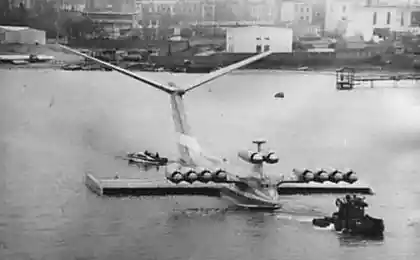283
Avro Vulcan
11 ph
+ a bit of text

Avro 698 Development began in 1947, when the Air Force ordered the development of high-speed high-altitude bomber carrying nuclear and conventional weapons.
The basis of the scheme adopted without the horizontal tail ("tailless") with deltoid wing, which was reflected in the appearance and, of course, the characteristics of the aircraft. Because of this he became very manoeuvrable as a car of this size and unobtrusive radar.
The aircraft - "pterodactyl" jet era, a distant relative of "Concord" (engines RR Olympus), support of RAF Bomber Command during the Cold War and the murderer navigators (catapults were just pilots, as in Victor with Valiant)
"Vulcan" was in service as a bomber until the end of the war Folklendskoy then converted into part of the tanker, flew to 1984.
After removal from service several aircraft (including XL426 and XH558) were used for the demonstration flight until 1992 when the unit was disbanded due to budget constraints the Air Force, and the planes were purchased by individuals.
XH558 was restored to flying condition and promise to keep it until 2013, when the resource expires engines.

Plane large,

... While a thin razor

Opening bombolyuka

Visible air brakes released.
In fact, in volcano currently not reduced, and performs a set height in a spiral. And the guards are not released then, to prevent the growth speed in a dive, and to reduce the vertical speed in the set.
This is due to thrust-weight ratio and high efficiency of the wing. Without shields climb so high that the aircraft would have scored 15,000 feet instead of the 5000.

Unfortunately, due to the requirements of GA aircraft performing instrument flight (but is now a civil aircraft, registration G-VLCN) Vulcan can only fly visually. As I understand it, no TCAS (Collision Warning aircraft in the air - Eng. Traffic alert and Collision Avoidance System, TCAS) and EPGWS (from Eng. Enhanced Ground Proximity Warning System - an advanced warning system on the approximation of the earth. EGPWS differs from conventional GPWS, working on the basis of the on-board radio altimeter, the presence of built-in database of terrain.).
Visual flight at such a monster to me seems a bit counter-intuitive and difficult.

And because of the limitations on the glider altitude increases wear (have to fly in a more dense and turbulent air).

Parachute was not - a long strip.

The nose is kept elevated for a long time, smoothly covered with snow, down the front rack and under applause taxied to the parking lot.

When I make a lot of money, I'll have your own volcano with blackjack and hookers painted in white "protivoatom»
via delta_bravo

Source:
+ a bit of text

Avro 698 Development began in 1947, when the Air Force ordered the development of high-speed high-altitude bomber carrying nuclear and conventional weapons.
The basis of the scheme adopted without the horizontal tail ("tailless") with deltoid wing, which was reflected in the appearance and, of course, the characteristics of the aircraft. Because of this he became very manoeuvrable as a car of this size and unobtrusive radar.
The aircraft - "pterodactyl" jet era, a distant relative of "Concord" (engines RR Olympus), support of RAF Bomber Command during the Cold War and the murderer navigators (catapults were just pilots, as in Victor with Valiant)
"Vulcan" was in service as a bomber until the end of the war Folklendskoy then converted into part of the tanker, flew to 1984.
After removal from service several aircraft (including XL426 and XH558) were used for the demonstration flight until 1992 when the unit was disbanded due to budget constraints the Air Force, and the planes were purchased by individuals.
XH558 was restored to flying condition and promise to keep it until 2013, when the resource expires engines.

Plane large,

... While a thin razor

Opening bombolyuka

Visible air brakes released.
In fact, in volcano currently not reduced, and performs a set height in a spiral. And the guards are not released then, to prevent the growth speed in a dive, and to reduce the vertical speed in the set.
This is due to thrust-weight ratio and high efficiency of the wing. Without shields climb so high that the aircraft would have scored 15,000 feet instead of the 5000.

Unfortunately, due to the requirements of GA aircraft performing instrument flight (but is now a civil aircraft, registration G-VLCN) Vulcan can only fly visually. As I understand it, no TCAS (Collision Warning aircraft in the air - Eng. Traffic alert and Collision Avoidance System, TCAS) and EPGWS (from Eng. Enhanced Ground Proximity Warning System - an advanced warning system on the approximation of the earth. EGPWS differs from conventional GPWS, working on the basis of the on-board radio altimeter, the presence of built-in database of terrain.).
Visual flight at such a monster to me seems a bit counter-intuitive and difficult.

And because of the limitations on the glider altitude increases wear (have to fly in a more dense and turbulent air).

Parachute was not - a long strip.

The nose is kept elevated for a long time, smoothly covered with snow, down the front rack and under applause taxied to the parking lot.

When I make a lot of money, I'll have your own volcano with blackjack and hookers painted in white "protivoatom»
via delta_bravo

Source:























